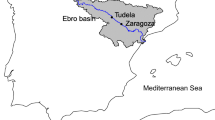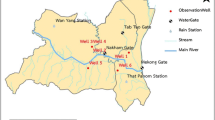Abstract
This work proposes a new statistical modelling approach to forecast the hourly river level at a gauging station, under potential flood risk situations and over a medium-term prediction horizon (around three days). For that aim we introduce a new model, the switching regression model with ARMA errors, which takes into account the serial correlation structure of the hourly level series, and the changing time delay between them. A whole modelling approach is developed, including a two-step estimation, which improves the medium-term prediction performance of the model, and uncertainty measures of the predictions. The proposed model not only provides predictions for longer periods than other statistical models, but also helps to understand the physics of the river, by characterizing the relationship between the river level in a gauging station and its influential factors. This approach is applied to forecast the Ebro River level at Zaragoza (Spain), using as input the series at Tudela. The approach has shown to be useful and the resulting model provides satisfactory hourly predictions, which can be fast and easily updated, together with their confidence intervals. The fitted model outperforms the predictions from other statistical and numerical models, specially in long prediction horizons.



Similar content being viewed by others
References
Abaurrea J, Asín J, Cebrián AC, García Vera M (2011) Trend analysis of water quality series based on regression models with correlated errors. J Hydrol 400:341–352
Aguilar J V, Langarita P, Linares L, Gómez M, Rodellar J (2013) An adaptive predictive approach for river level forecasting. J Hydroinform 15(2):232–245
Alvisi S, Mascellani G, Franchini M, Bárdossy A (2006) Water level forecasting through fuzzy logic and artificial neural network approaches. Hydrol Earth Syst Sci 10:1–17
Amiri E (2015) Forecasting daily river flows using nonlinear time series models. J Hydrol 527:1054–1072
Brockwell P J, Davis R A (2016) Introduction to time series and forecasting, 3rd edn. Springer, Berlin
CHE (2015) Informe sobre las avenidas del primer trimestre de 2015 en la cuenca del Ebro. Tech. rep., Confederación Hidrográfica del Ebro, http://www.chebro.es
Gunther F, Fritsch S (2010) neuralnet: training of neural networks. R Journal 2(1):30–38
Harvey A C (1993) Time series models. Harvester Wheatsheaf, New York
Hubrich K, Terasvirta T (2013) Thresholds and smooth transitions in vector autoregressive models. Adv Econ 32:273–326
Keskin M, Taylan D, Terzi O (2006) Adaptive neural-based fuzzy inference system (ANFIS) approach for modelling hydrological time series. Hydrol Sci J 51 (4):588–598
Kisi O (2011) Wavelet regression model as an alternative to neural networks for river stage forecasting. Water Resour Manag 25(2):579–600
Leahy P, Kiely G, Corcoran G (2008) Structural optimisation and input selection of an artificial neural network for river level prediction. J Hydrol 355:192–201
Ling S, Tong H, Li D (2007) Ergodicity and invertibility of threshold moving-average models. Bernoulli 13(1):161–168
Makridakis S, Wheelwright S C, Hyndman R J (2008) Adv Economing methods and applications. Wiley, New York
Matos J, Portela M, Schleiss A (2018) Towards safer data-driven forecasting of extreme streamflows. Water Resour Manag 32:701–720
Pedregal D, Rivas R, Feliu V, Sánchez L, Linares A (2009) A non-linear forecasting system for the Ebro river at Zaragoza, Spain. Environ Modell Softw 24 (4):502–509
Pulukuri S, Keesara V, Deva P (2018) Flow forecasting in a watershed using autoregressive updating model. Water Resour Manag 32(8):2701–2716
Sen Z (2017) Fuzzy logic and hydrological modeling. CRC Press, Boca Raton
Thielen J, Bartholmes J, Ramos M H, Roo A D (2009) The European flood alert system. Part 1: concept and development. Hydrol Earth Syst Sci 13(2):125–140
Tong H, Thanoon B, Gudmundsson G (1985) Threshold time series modeling of two icelandic riverflow systems. J Am Water Resour As 21(4):651–662
Wei C C (2016) Comparing single-and two-segment statistical models with a conceptual rainfall-runoff model for river streamflow prediction during typhoons. Environ Modell Softw 85:112–128
Xu W, Jiang C, Yan L, Li L, Liu S (2018) An adaptive metropolis-hastings optimization algorithm of bayesian estimation in non-stationary flood frequency analysis. Water Resour Manag 32:1343–1366
Yadav B, Ch S, Mathur S, Adamowski J (2016) Discharge forecasting using an online sequential extreme learning machine (OS-ELM) model: a case study in Neckar river, Germany. Measurement 92:433–445
Acknowledgements
The authors are members of the research group Modelos Estocásticos, supported by the DGA, the European Social Fund and the project MTM2017-83812-P. The authors acknowledge CHE and especially G. Pérez and J.A. Álvarez for supplying the data and their advice. The authors thank the anonymous referees for their valuable comments.
Author information
Authors and Affiliations
Corresponding author
Ethics declarations
Conflict of Interest
None
Electronic supplementary material
Below is the link to the electronic supplementary material.
Rights and permissions
About this article
Cite this article
Cebrián, A.C., Abaurrea, J., Asín, J. et al. Dynamic Regression Model for Hourly River Level Forecasting Under Risk Situations: an Application to the Ebro River. Water Resour Manage 33, 523–537 (2019). https://doi.org/10.1007/s11269-018-2114-2
Received:
Accepted:
Published:
Issue Date:
DOI: https://doi.org/10.1007/s11269-018-2114-2




